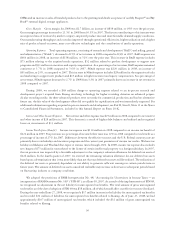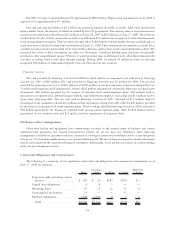Western Digital 2008 Annual Report Download - page 42
Download and view the complete annual report
Please find page 42 of the 2008 Western Digital annual report below. You can navigate through the pages in the report by either clicking on the pages listed below, or by using the keyword search tool below to find specific information within the annual report.OEMs and an increase in sales of branded products due to the growing worldwide acceptance of our My Passport»and My
Book»external digital storage appliances.
Gross Margin. Gross margin for 2008 was $1.7 billion, an increase of $839 million, or 93% over the prior year.
Gross margin percentage increased to 21.5% in 2008 from 16.5% in 2007. The factors contributing to this increase were
an improved mix of revenues by market category, improved product mix and more favorable demand/supply conditions.
Our manufacturing throughput and costs also improved through operational efficiencies, higher utilization and a higher
mix of products based on newer, more cost-effective technologies and the contribution of media operations.
Operating Expenses. Total operating expenses, consisting of research and development (“R&D”) and selling, general
and administrative (“SG&A”), decreased to 8.5% of net revenue in 2008 compared to 8.9% in 2007. R&D expense was
$464 million in 2008, an increase of $158 million, or 52% over the prior year. This increase in R&D expense includes
$75 million relating to the acquired media operations, $52 million related to product development to support new
programs and $31 million in incentive and equity compensation. As a percentage of net revenue, R&D expense remained
consistent at 5.7% in 2008 compared to 5.6% in 2007. SG&A expense was $220 million in 2008, an increase of
$41 million, or 23%, as compared to 2007. This increase in SG&A expense includes $28 million for the expansion of sales
and marketing to support new products and $13 million in higher incentive and equity compensation. As a percentage of
net revenue, SG&A expense decreased to 2.7% in 2008 from 3.3% in 2007 primarily due to an increase in net revenue in
2008 compared to 2007.
During 2008, we recorded a $49 million charge to operating expense related to an in-process research and
development project acquired from Komag involving technology for higher recording densities on advanced perpen-
dicular recording media. As these advanced products were not ready for commercial production and had no alternative
future use, the fair value of the development effort did not qualify for capitalization and was immediately expensed. For
additional information regarding acquired in-process research and development, see Part II, Item 8, Note 11 in the Notes
to Consolidated Financial Statements, included in this Annual Report on Form 10-K.
Interest and Other Income (Expense). Net interest and other expense was $25 million in 2008 compared to net interest
and other income of $28 million in 2007. This decrease is a result of higher debt balances and realized and recognized
losses on investments of $13 million.
Income Tax Expense (Benefit). Income tax expense was $114 million in 2008 compared to an income tax benefit of
$121 million in 2007. Tax provision as a percentage of income before taxes was 12% in 2008 compared to tax benefit as a
percentage of income of 27% for 2007. Differences between the effective tax rates and the U.S. Federal statutory rate are
primarily due to tax holidays and incentive programs and the current year generation of income tax credits. We have tax
holidays in Malaysia and Thailand that expire at various times through 2022. In 2008, income tax expense also includes
net charges of $75 million for taxes related to the license of certain intellectual property to a foreign subsidiary. In 2007,
the tax provision was impacted by a favorable adjustment to the company’s valuation allowance for deferred tax assets of
$126 million. In the fourth quarter of 2007, we reversed the remaining valuation allowance for our deferred tax assets
based upon a determination that it was more likely than not that our deferred tax assets will be realized. The realization of
the deferred tax assets is primarily dependent on our ability to generate sufficient earnings in certain jurisdictions in
future years. The amount of deferred tax assets considered realizable may increase or decrease in subsequent periods based
on fluctuating industry or company conditions.
We adopted the provisions of FASB Interpretation No. 48, “Accounting for Uncertainty in Income Taxes — an
interpretation of FASB Statement No. 109” (“FIN 48”), as of June 30, 2007. As a result of the implementation of FIN 48,
we recognized no adjustment in the net liability for unrecognized tax benefits. The total amount of gross unrecognized
tax benefits as of the date of adoption of FIN 48 was $58 million, all of which would affect our effective tax rate if realized.
During the year ended June 27, 2008, we recognized a $17 million increase in the liability for unrecognized tax benefits
and recorded $32 million of liabilities for unrecognized tax benefits related to Komag. As of June 27, 2008, we had
approximately $107 million of unrecognized tax benefits which included the $32 million of gross unrecognized tax
benefits related to Komag.
36
























